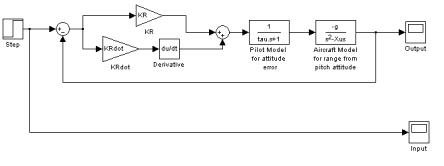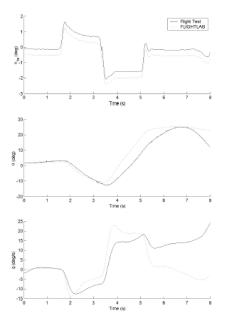
Flight Science & Technology Research Group
The Adaptive Pilot Model in Simulation Fidelity
Department Home
Page
Courses
Simulation
Facilities
Feedback: mdw@liv.ac.uk
The level of fidelity of Flight Simulators, or, more generally Synthetic Training Devices (STD), determines their fitness for purpose and is quantified in documents like JAR-STD-1H in terms of performance criteria for the individual components, e.g. the motion/visual/sound systems, the mathematical model.
Component fidelity is important but the standards also require piloted assessment of the integrated system with typical mission sorties flown covering the training aspects for which the system will be used. Subjective opinion here is important too because it reflects the value that an experienced pilot places on the level of realism. Quantifying overall simulation fidelity is more difficult however, but is equally important because, arguably, component or sub-system fidelity can only be properly related to fitness for purpose if connected by measure to the whole.
Attempts to quantify overall simulation fidelity within the framework of handling qualities engineering have been presented in a number of forms in recent years. Hess and colleagues have developed an approach based on pilot-aircraft modelling and introduced the handling qualities sensitivity function as the basis of a quality metric. McCallum et al propose the use of the ADS-33 performance standards for deriving metrics. Within the JSHIP project, Wilkinson and Advani, and Roscoe and Thompson present an approach using comparative measures of performance and control activity, correlated with handling qualities ratings given for the same tasks flown in simulation and flight. In all these approaches, the philosophy has been to develop a rational and systematic approach to identifying differences between tasks performed in simulation and flight, hence directing attention to simulation deficiencies. While JAR-STD 1H is directed at the training community, fidelity criteria are equally applicable to simulation in design, research and development. In these areas, flight simulation can be a primary source of data from which knowledge is derived, decisions are made and significant resources committed.
 This
research continues the development of an approach for quantifying
overall simulation fidelity based on an analysis of pilot visual
guidance strategy, identifying the control loops utilised, levels
of abruptness and the cues available to support anticipation. The
premise is that if the control strategy adopted to perform the same
flying task is ‘equivalent’ in flight and simulation, then the
fidelity is good and the training device fit for purpose.
The meaning of equivalent is developed in terms of what we
describe as the Adaptive
Pilot Model (APM) concept, whereby the combined pilot and
aircraft is modelled and comparisons made of model parameters
identified from the same curve fitting process applied to data from
flight and simulation tests. As
with previous studies, the research is thus concerned with
approximations for describing the behaviour of the combined
pilot-aircraft system. However,
in the present work, it is assumed that the pilot adapts control
strategy during the manoeuvre, with the adaptation reflected in the
changing model parameters. Thus
the changing pilot gains relating to velocity and distance control,
for example, are tracked through the manoeuvre.
The concept can be extended under the premise that motion
control by the pilot follows temporal rather than spatial guidance
principles. The
results gained through analysing the way in which helicopter pilots
manoeuvre indicate that pilots strictly have no need for velocity
or distance information, per se, when manoeuvring close to a
surface. Instead, they
use information about time to close on surfaces, t(t),
to make judgements about relative motion and control requirements.
This
research continues the development of an approach for quantifying
overall simulation fidelity based on an analysis of pilot visual
guidance strategy, identifying the control loops utilised, levels
of abruptness and the cues available to support anticipation. The
premise is that if the control strategy adopted to perform the same
flying task is ‘equivalent’ in flight and simulation, then the
fidelity is good and the training device fit for purpose.
The meaning of equivalent is developed in terms of what we
describe as the Adaptive
Pilot Model (APM) concept, whereby the combined pilot and
aircraft is modelled and comparisons made of model parameters
identified from the same curve fitting process applied to data from
flight and simulation tests. As
with previous studies, the research is thus concerned with
approximations for describing the behaviour of the combined
pilot-aircraft system. However,
in the present work, it is assumed that the pilot adapts control
strategy during the manoeuvre, with the adaptation reflected in the
changing model parameters. Thus
the changing pilot gains relating to velocity and distance control,
for example, are tracked through the manoeuvre.
The concept can be extended under the premise that motion
control by the pilot follows temporal rather than spatial guidance
principles. The
results gained through analysing the way in which helicopter pilots
manoeuvre indicate that pilots strictly have no need for velocity
or distance information, per se, when manoeuvring close to a
surface. Instead, they
use information about time to close on surfaces, t(t),
to make judgements about relative motion and control requirements.
Areas
for innovation in the research include;
-
Prediction and understanding of changes of pilot control strategy during manoeuvres through APM
-
Extend guidance APM to include stabilisation
-
Develop simulation fidelity criteria
-
Explain different piloting techniques through the APM concept

Figure 1
- Response to Longitudinal Cyclic in Hover, Comparison of Flight
Test and FLIGHTLAB Simulation – Bo105
Members: